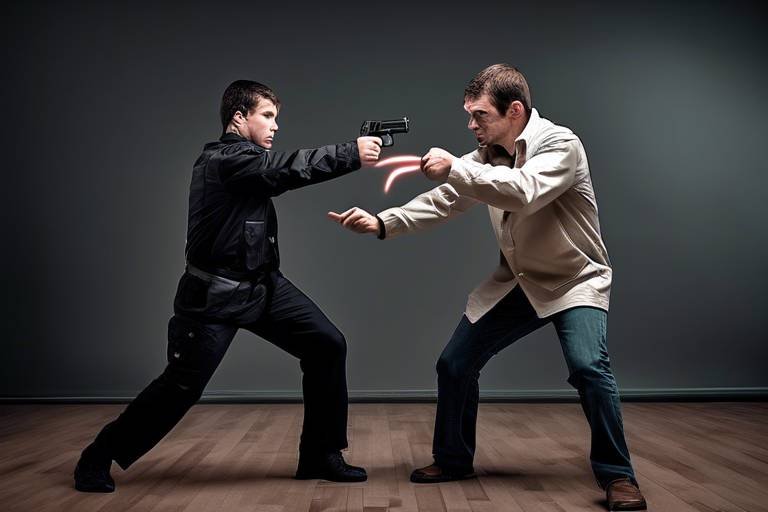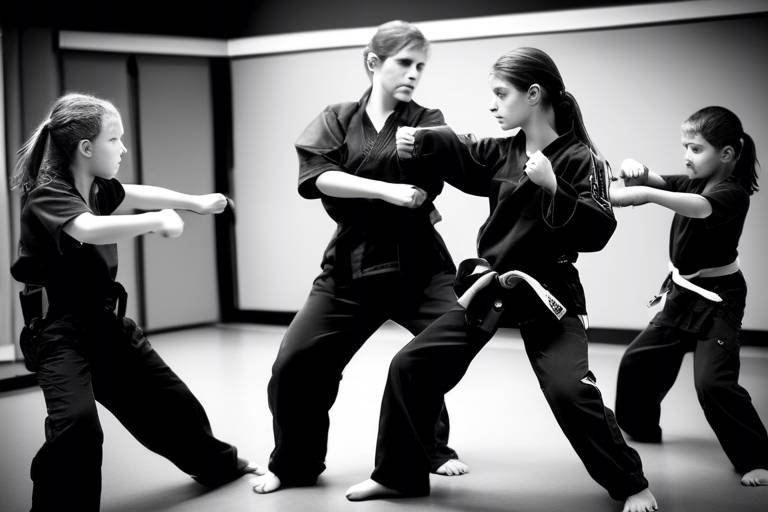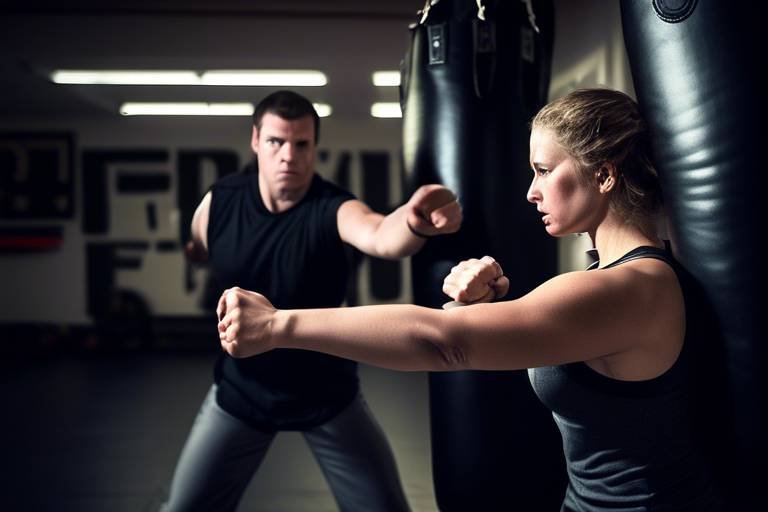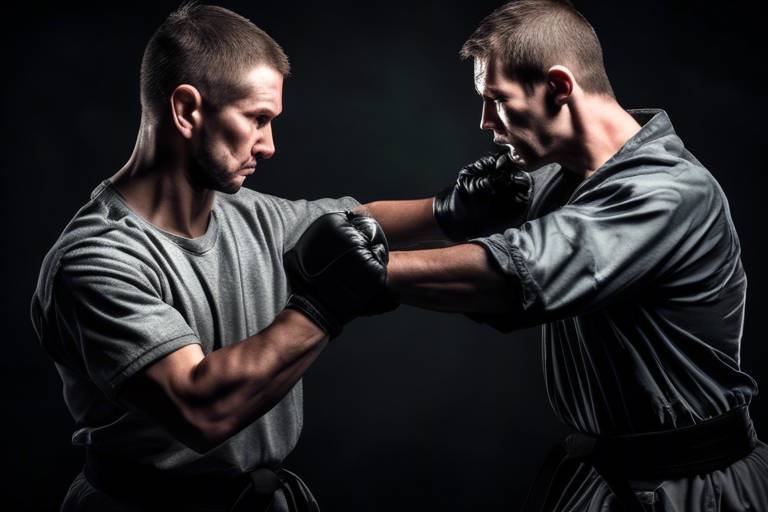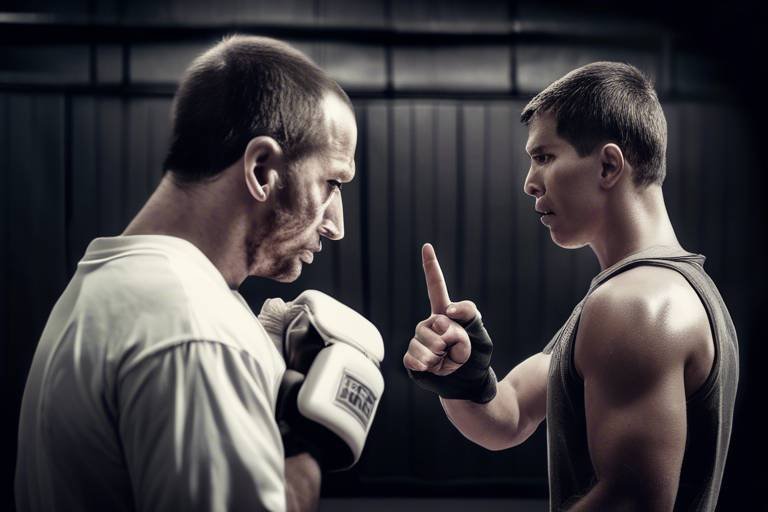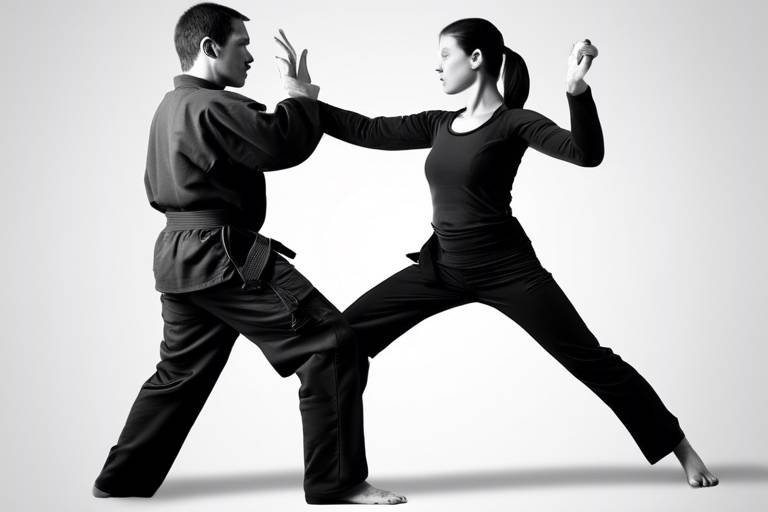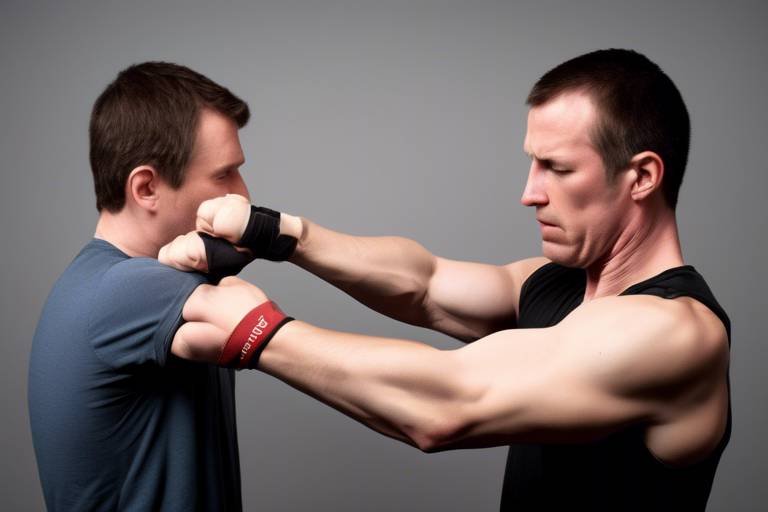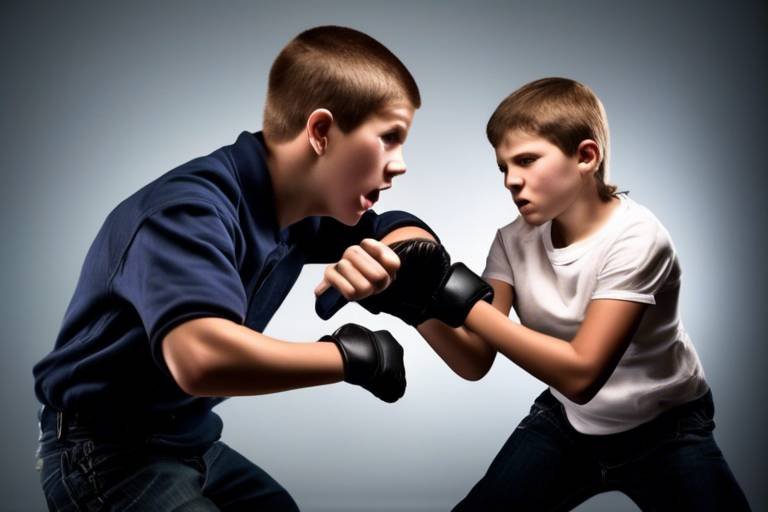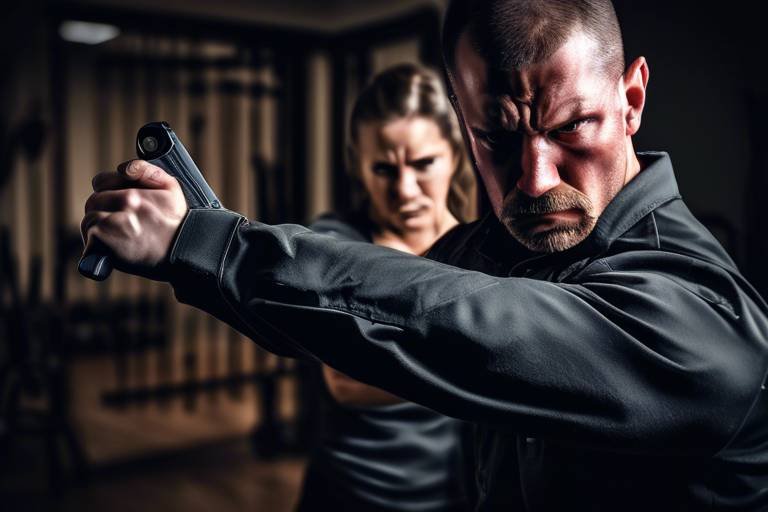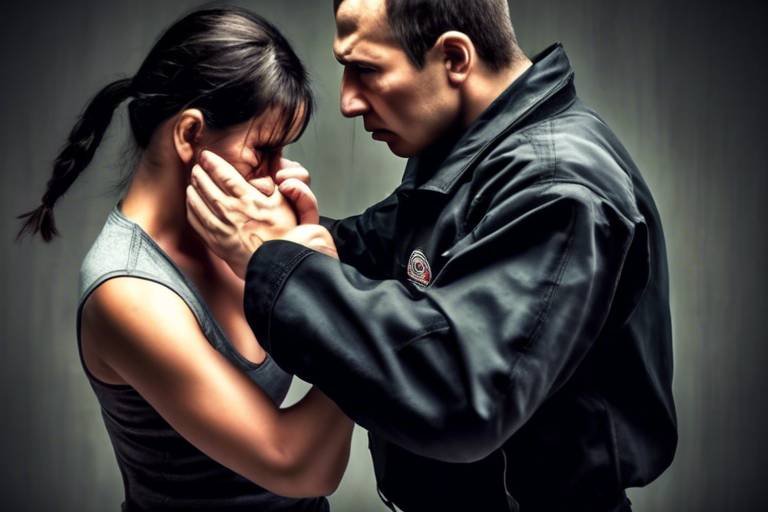ABCs of Self-Defense Training and What They Mean
Self-defense training is not just about learning how to throw a punch or deliver a kick; it's an empowering journey that equips individuals with the skills and mindset necessary to protect themselves in potentially dangerous situations. In a world where unpredictability is the norm, understanding the ABCs of self-defense can mean the difference between safety and vulnerability. So, what exactly do the ABCs stand for? They symbolize Awareness, Basics, and Confidence—three fundamental pillars that form the foundation of effective self-defense.
Awareness is the first step in self-defense. It’s about being conscious of your surroundings and recognizing potential threats before they escalate into dangerous encounters. Imagine walking down a dimly lit street; if your head is buried in your phone, you’re less likely to notice someone following you. By developing a heightened sense of awareness, you can identify risky situations and take preventive measures. This aspect of self-defense training is crucial, as it empowers you to avoid confrontation whenever possible.
Next comes the Basics. These are the fundamental techniques and strategies that every self-defense student should master. From striking and blocking to escaping holds, the basics provide the tools you need to respond effectively if a confrontation occurs. Practicing these techniques not only builds muscle memory but also prepares you mentally for real-life scenarios. Think of it as learning to ride a bike; once you grasp the basics, you can navigate any path with confidence.
Finally, we have Confidence. This is perhaps the most vital component of self-defense training. Confidence is not just about physical ability; it’s about believing in yourself and your capacity to handle challenging situations. This self-belief can be cultivated through consistent practice and positive reinforcement. When you know you have the skills to protect yourself, you're more likely to stand your ground and respond effectively in times of crisis. It’s like having an invisible shield that bolsters your resolve.
Incorporating these ABCs into your self-defense training can lead to a transformative experience. By enhancing your awareness, mastering the basics, and building your confidence, you’ll be well-equipped to face whatever challenges come your way. Remember, self-defense is not just about physical confrontation; it’s about empowerment, preparedness, and the ability to navigate life’s uncertainties with assurance.
- What is self-defense? Self-defense is the ability to protect oneself from harm using various techniques and strategies.
- Do I need to be physically strong to learn self-defense? No, self-defense relies on technique, strategy, and mental preparedness rather than sheer strength.
- How can I improve my situational awareness? Practice being mindful of your surroundings, and engage in activities that require focus and observation.
- Is self-defense training suitable for everyone? Yes, self-defense training can benefit individuals of all ages and physical abilities.

Understanding Self-Defense
Self-defense is not just about physical prowess; it embodies the ability to protect oneself from harm, both physically and psychologically. It's a concept that intertwines legality, ethics, and practical application. Understanding self-defense means grasping the nuances of when and how to apply various techniques effectively. Imagine standing in a crowded place and suddenly feeling threatened; your instincts kick in, and you need to know whether to stand your ground, de-escalate the situation, or prepare to defend yourself. This is where understanding self-defense becomes crucial.
The legal implications of self-defense are paramount. In many jurisdictions, the law allows individuals to use reasonable force to protect themselves from imminent harm. However, what constitutes "reasonable" can vary significantly, so it's vital to familiarize yourself with local laws. For instance, the use of force must typically be proportional to the threat faced. If someone pushes you, responding with a lethal weapon could lead to severe legal consequences. Therefore, knowing your rights and the legal framework surrounding self-defense can empower you to act wisely in a crisis.
Ethical considerations also play a significant role in self-defense. It's essential to reflect on the moral implications of your actions. Self-defense should ideally be a last resort, employed only when there are no other options available. This means understanding the difference between self-defense and aggression. When faced with a potential threat, ask yourself: Is there a way to avoid confrontation? The ability to de-escalate a situation can often prevent the need for physical self-defense altogether.
Moreover, recognizing the right moment to apply self-defense techniques is critical. Many people underestimate their ability to read situations. Developing a keen sense of awareness can help you identify potential threats before they escalate. For example, if you notice someone following you closely or behaving suspiciously, it’s essential to trust your instincts and take preventative measures, such as changing your route or seeking help.
In summary, understanding self-defense encompasses a blend of legal knowledge, ethical considerations, and situational awareness. It’s about preparing your mind as much as your body. As you embark on your self-defense journey, remember that being equipped with the right knowledge and skills can significantly enhance your ability to protect yourself and make informed decisions in high-pressure situations.
- What is the primary goal of self-defense? The primary goal is to protect oneself from harm while minimizing injury to all parties involved.
- Is self-defense legal everywhere? Self-defense laws vary by location, so it's crucial to understand the laws specific to your area.
- Can self-defense techniques be used in any situation? Self-defense techniques should only be used when there is an imminent threat and no other option is available.
- How can I improve my self-defense skills? Regular practice, training, and situational awareness are key to improving your self-defense skills.
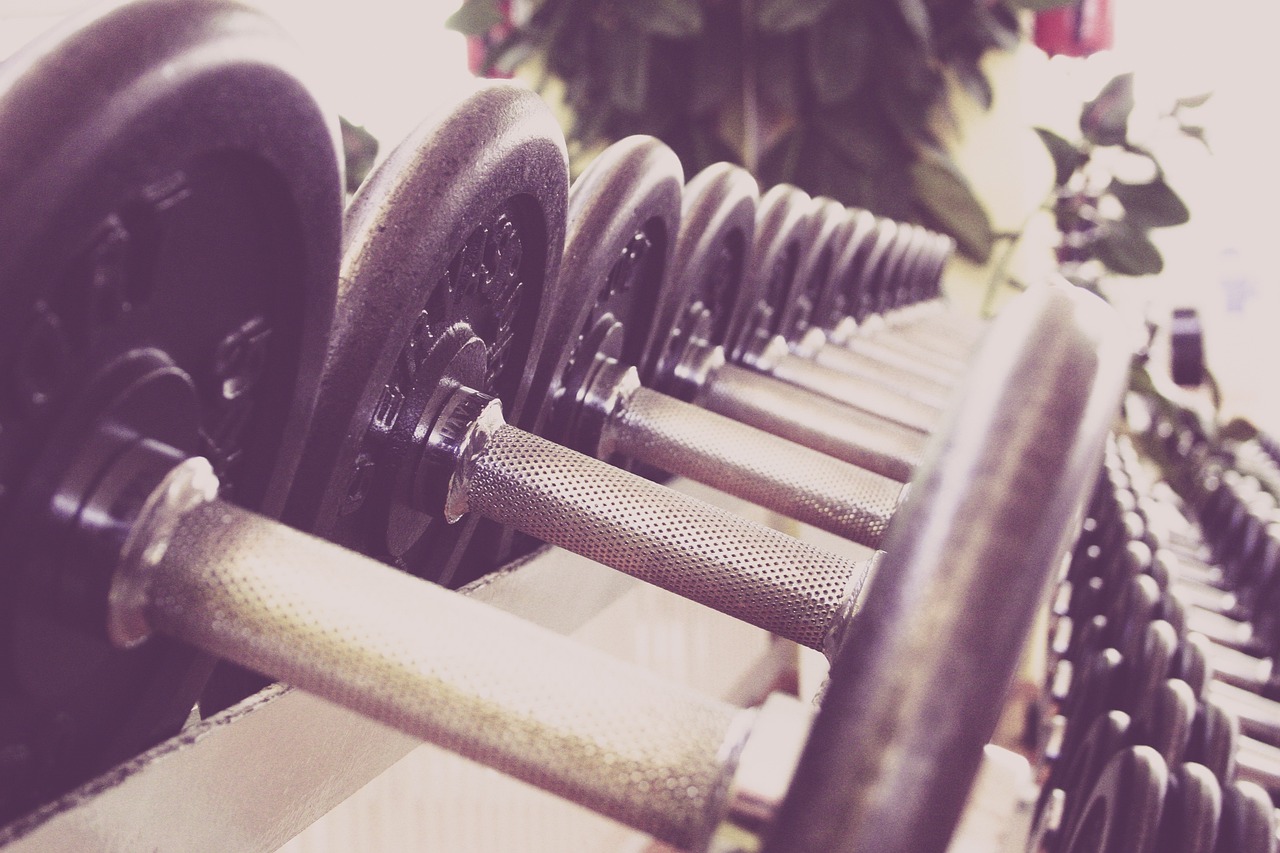
Physical Techniques
When it comes to self-defense, mastering is crucial for anyone looking to protect themselves. These techniques are not just about brute strength; they encompass a variety of movements and strategies designed to help individuals respond effectively to potential threats while minimizing risk. Think of physical techniques as the toolkit you carry with you—each tool has its specific purpose, and knowing how to use them can mean the difference between safety and harm. In this section, we will explore essential techniques, focusing on striking methods, defensive maneuvers, and how they can empower you in a threatening situation.
One of the foundational elements of self-defense is the ability to strike effectively. Striking techniques, including punches and kicks, are vital for creating distance and disabling an attacker. But it’s not just about throwing punches wildly; it’s about understanding proper form and targeting specific areas of the body for maximum impact. For instance, a well-placed punch to the nose or a swift kick to the knee can incapacitate an assailant, allowing you the chance to escape. The effectiveness of these techniques lies in their execution, which is why consistent practice is essential.
Striking techniques can be divided into two main categories: punching and kicking. Each of these techniques serves a unique purpose and can be applied in various scenarios. For example, punches can be used in close-quarter situations where you may not have room to maneuver, while kicks are particularly effective for creating distance between you and an attacker. Understanding when to use each technique is vital, and this requires both training and intuition.
Let’s dive deeper into punching techniques. Effective punching can disable an attacker and give you the upper hand. There are several types of punches, including the jab, cross, hook, and uppercut. Each punch has its own mechanics and applications:
| Type of Punch | Description | Application |
|---|---|---|
| Jab | A quick, straight punch thrown with the lead hand. | Used to gauge distance and set up for more powerful strikes. |
| Cross | A powerful straight punch thrown with the rear hand. | Effective for delivering significant force to an opponent. |
| Hook | A punch that travels in a circular motion to hit the side of the opponent's head. | Ideal for close-range combat. |
| Uppercut | A punch that travels upward, targeting the chin. | Great for catching an opponent off guard. |
To improve your punching speed and power, focus on your stance and body mechanics. Your feet should be shoulder-width apart, and you should pivot your hips and shoulders to generate force. Regular practice with a punching bag or during sparring sessions can significantly enhance your skills.
Kicking techniques are equally important in self-defense. They can create distance between you and an attacker, giving you the opportunity to escape or prepare for your next move. There are various types of kicks, such as front kicks, roundhouse kicks, and side kicks. Each kick serves a different purpose:
- Front Kick: A straightforward kick that targets the groin or abdomen, effective for pushing an attacker away.
- Roundhouse Kick: A powerful kick that strikes with the shin or foot, ideal for targeting the head or torso.
- Side Kick: A kick that delivers force from the side, excellent for maintaining distance and balance.
When executing kicks, focus on your balance and control. Ensure that you’re not overextending yourself, as this can leave you vulnerable to counterattacks. Practicing kicks in front of a mirror can help you refine your technique and boost your confidence.
In addition to striking, defensive maneuvers play a crucial role in self-defense. Techniques such as blocking and redirecting attacks can help you avoid harm. Blocking involves using your arms or legs to intercept an incoming strike, while redirecting allows you to use an attacker’s momentum against them. These maneuvers require timing and precision, making them essential skills to master through regular practice.
In summary, physical techniques in self-defense are not just about fighting back; they’re about knowing how to respond effectively to threats. By combining striking techniques with defensive maneuvers, you can create a comprehensive strategy that empowers you to protect yourself. Remember, practice is key—so get out there and hone your skills!
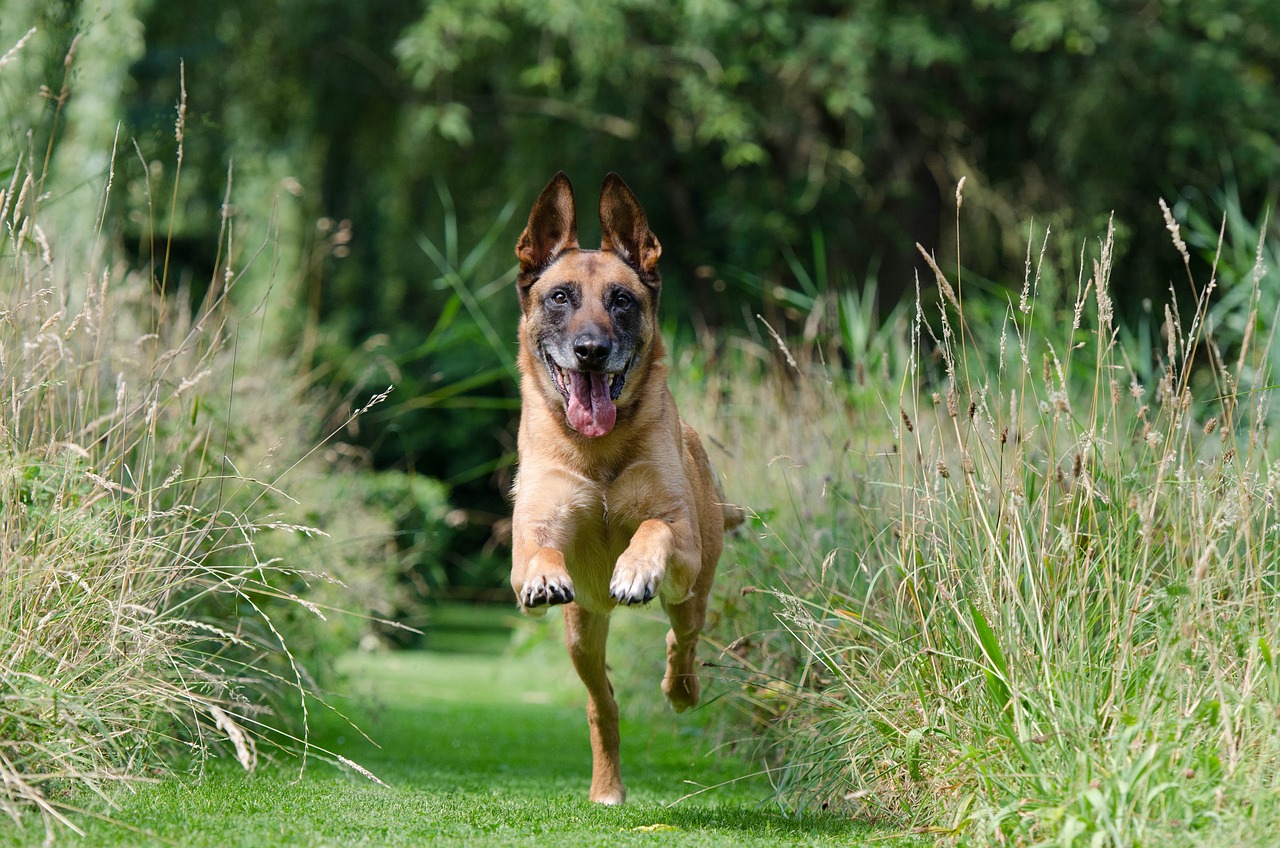
Striking Techniques
When it comes to self-defense, are your frontline warriors. These are the moves that can help you create space, deter an attacker, or even incapacitate them if necessary. Imagine being in a situation where you feel threatened; the ability to deliver a precise strike can be the difference between safety and harm. Striking techniques encompass a variety of methods, including punches, kicks, and even elbows and knees, each designed to maximize impact while minimizing risk to yourself.
One of the most important aspects of striking is proper form. Whether you’re throwing a punch or delivering a kick, maintaining the right posture and alignment is crucial for both effectiveness and safety. Think of it like playing a sport; just as a basketball player needs to shoot with proper technique to score, a person defending themselves needs to strike with precision to protect themselves effectively. Let’s break down some of the key striking techniques that everyone should consider mastering.
Punching is often the first thing that comes to mind when we think about striking in self-defense. A well-executed punch can disable an attacker and give you the opportunity to escape. There are several types of punches to consider:
- Jab: A quick, straight punch that can disrupt an attacker's rhythm.
- Cross: A powerful punch thrown with the rear hand, often used to follow up a jab.
- Hook: A punch that comes from the side, targeting the jaw or temple.
- Uppercut: A punch that travels upward, targeting the chin or jaw, perfect for close-range encounters.
To improve your punching speed and power, focus on the following:
- Practice regularly to build muscle memory.
- Work on your footwork to maintain balance and agility.
- Incorporate strength training to enhance your overall power.
Kicking techniques are equally important as they allow you to create distance between yourself and an attacker. A well-placed kick can keep an assailant at bay, giving you a chance to escape or regroup. Here are some common kicking techniques to consider:
- Front Kick: A direct kick aimed at the opponent's midsection or face, useful for pushing them away.
- Roundhouse Kick: A powerful kick delivered in a circular motion, targeting the head or body.
- Side Kick: A kick that strikes with the heel, effective for creating distance.
- Back Kick: A kick delivered backwards, useful if you’re being approached from behind.
To execute these kicks safely and effectively, remember to:
- Practice your kicks on a heavy bag to develop power.
- Focus on your balance to avoid falling or losing control.
- Ensure your target is clear to avoid unnecessary injury to yourself or others.
In conclusion, mastering striking techniques is essential for anyone interested in self-defense. Not only do these techniques empower you to protect yourself, but they also build confidence and awareness. So, whether you’re practicing jabs in your living room or perfecting your roundhouse kick at a dojo, remember that every strike counts towards your personal safety and empowerment.
Q: Do I need to be strong to be effective in self-defense?
A: Not at all! While strength can help, technique and strategy are far more important. Many self-defense techniques rely on leverage and timing rather than brute force.
Q: How often should I practice striking techniques?
A: Consistency is key! Aim for at least 2-3 practice sessions per week to build muscle memory and confidence.
Q: Is self-defense training suitable for everyone?
A: Yes! Self-defense training can benefit individuals of all ages and fitness levels. It’s all about finding the right techniques that work for you.
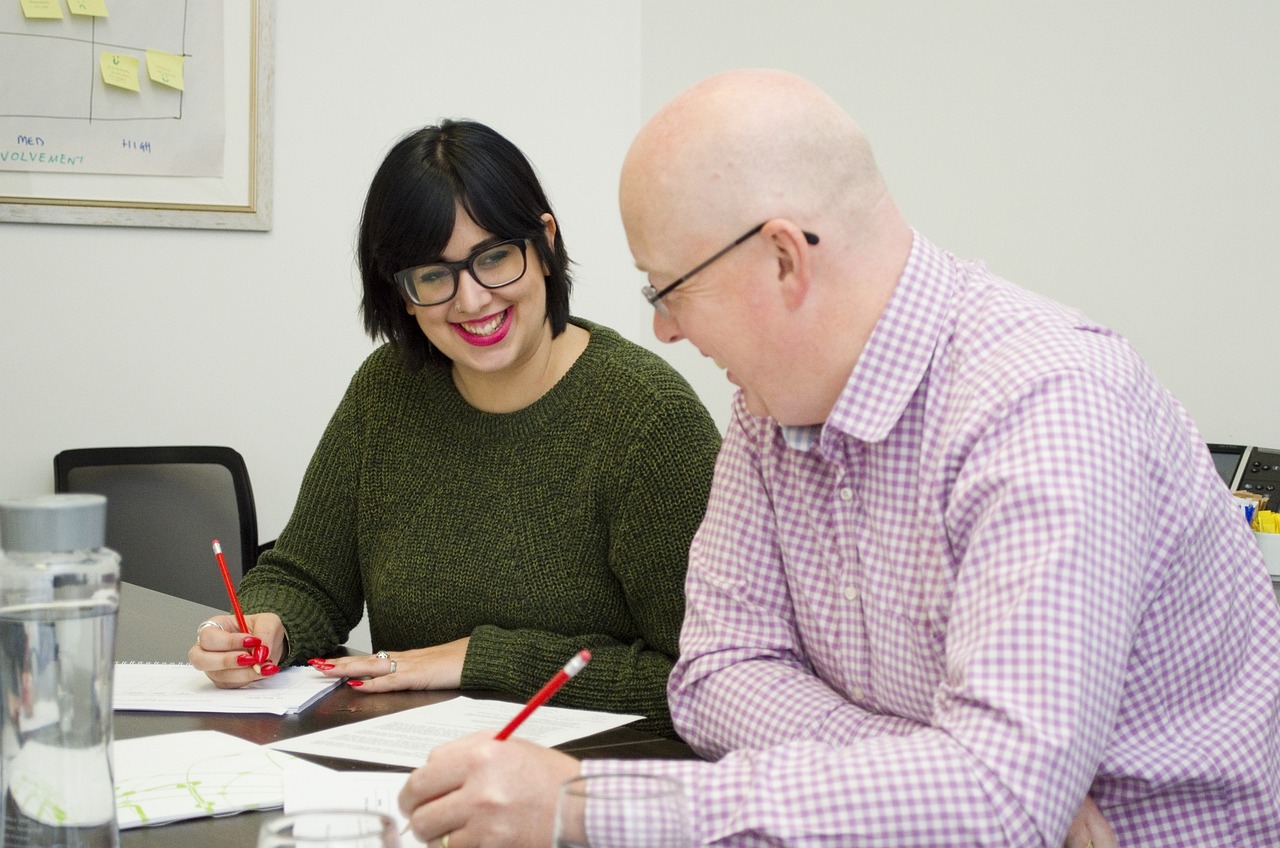
Punching Techniques
Punching techniques are among the most fundamental components of self-defense. Whether you're training in martial arts or simply looking to enhance your personal safety, understanding how to punch effectively can make a significant difference in a confrontation. A good punch can not only disable an attacker but also create an opportunity for escape. So, let's delve into the various types of punches, their applications, and how to improve your technique.
There are several types of punches that you should familiarize yourself with, each serving a unique purpose in a self-defense scenario. Here are some of the most common punching techniques:
- Jab: A quick, straight punch thrown with the lead hand. This is ideal for keeping an attacker at bay and gauging distance.
- Cross: A powerful punch thrown with the rear hand. It’s often used in combination with a jab to maximize impact.
- Hook: A punch that comes from the side, targeting the opponent's jaw or temple. This can be devastating if executed correctly.
- Uppercut: An upward punch that can catch an opponent off guard, especially if they are leaning forward.
When it comes to executing these punches, form is everything. Proper stance and alignment can amplify the effectiveness of your strikes. Here are some tips to keep in mind:
| Technique | Key Points |
|---|---|
| Jab | Keep your elbow in, rotate your shoulder, and extend your arm fully. |
| Cross | Pivot your rear foot, rotate your hips, and follow through with your fist. |
| Hook | Keep your elbow at shoulder height and swing your arm in a circular motion. |
| Uppercut | Bend your knees slightly and drive your punch upward from your hip. |
In addition to mastering the techniques, practicing regularly is crucial. Shadow boxing, hitting a heavy bag, or working with a partner can significantly enhance your punching power and speed. Remember, the goal is not just to throw a punch but to do so with precision and confidence. The more you train, the more natural these movements will become, allowing you to react instinctively in a real-life situation.
Finally, let’s not forget the mental aspect of punching. Visualization techniques can help you anticipate your moves and prepare for various scenarios. Imagine yourself in a situation where you need to defend yourself, and visualize how you would execute each punch. This mental rehearsal can boost your confidence and readiness, making you feel more capable when it matters most.
- What is the best punch for self-defense? The jab is often considered the best initial punch for self-defense as it allows you to maintain distance while assessing the situation.
- How can I improve my punching power? Focus on your stance, engage your core, and practice regularly. Strength training can also enhance your overall power.
- Is it necessary to have formal training to punch effectively? While you can learn basic techniques on your own, formal training can provide valuable feedback and help you refine your skills.

Kicking Techniques
Kicking techniques are a powerful component of self-defense, offering not only a means to defend oneself but also a way to maintain distance from an attacker. When executed correctly, kicks can create the necessary space to escape a dangerous situation. Think of your legs as a shield; they can either keep an attacker at bay or propel you out of harm's way. In this section, we will explore the various types of kicks, their applications in self-defense, and tips for executing them safely and effectively.
There are several fundamental kicking techniques, each with its unique purpose and application. Here are some of the most commonly used kicks in self-defense:
- Front Kick: This is a straightforward kick that targets an attacker's midsection or face. It’s particularly effective because it can be delivered quickly and with considerable force.
- Roundhouse Kick: This kick involves swinging your leg in a circular motion, striking with the shin or the top of the foot. It is excellent for targeting the side of an opponent's body and can be devastating if executed with speed and precision.
- Side Kick: A side kick is powerful and can generate a significant amount of force. It’s executed by extending the leg sideways, aiming for the opponent's torso or knee, making it an effective technique for disabling an attacker.
- Back Kick: This kick is delivered by thrusting the heel backward, making it particularly useful when an attacker is approaching from behind. It can catch an opponent off guard and create an opportunity to escape.
To execute these kicks effectively, proper form is crucial. Here are a few tips to keep in mind:
| Kick Type | Target Area | Execution Tips |
|---|---|---|
| Front Kick | Midsection/Face | Keep your knee high and extend your foot forward; aim for the solar plexus for maximum impact. |
| Roundhouse Kick | Side of Body | Pivot on your supporting foot and rotate your hips to generate power; strike with the shin. |
| Side Kick | Torso/Knee | Chamber your leg and extend it sideways while keeping your body balanced; focus on the heel for impact. |
| Back Kick | Behind | Look over your shoulder to gauge distance and thrust your heel back; maintain your balance. |
When practicing these techniques, it’s important to start slow and build up to faster speeds as you become more comfortable. This not only helps in perfecting your form but also reduces the risk of injury. Always warm up before your practice sessions to prepare your muscles and joints for the workout ahead. Consider working with a partner or coach who can provide feedback and help you refine your techniques.
Incorporating kicking techniques into your self-defense training can significantly enhance your ability to respond to various situations. Remember, the goal of self-defense is not to engage in combat but to create an opportunity to escape and seek safety. By mastering these kicking techniques, you empower yourself to handle potential threats with confidence and skill.
Q: Can anyone learn kicking techniques for self-defense?
A: Absolutely! Kicking techniques can be learned by individuals of all skill levels. With proper instruction and practice, anyone can develop the necessary skills.
Q: How often should I practice my kicking techniques?
A: Consistent practice is key. Aim to practice at least two to three times a week to build muscle memory and improve your technique.
Q: Are kicking techniques effective against all attackers?
A: While kicking techniques are powerful, their effectiveness can depend on various factors, including the size and strength of the attacker. The goal is to create distance and escape, not to engage in a prolonged fight.

Defensive Maneuvers
Defensive maneuvers are the unsung heroes of self-defense training. They are the techniques that allow you to avoid harm when faced with an attack. Imagine being in a high-pressure situation where every second counts; knowing how to block or redirect an attack can be the difference between safety and injury. These maneuvers are not just about physical actions; they require a keen sense of timing and awareness of your surroundings. In this section, we’ll explore some essential defensive techniques that every self-defense practitioner should master.
One of the most fundamental defensive maneuvers is the block. A block serves as a barrier between you and an incoming strike. It’s crucial to understand that blocking is not merely about putting your arm up; it's about positioning your body in a way that minimizes the impact. For example, when blocking a punch, you should turn your wrist and arm to deflect the force away from your body. This technique not only protects you but also opens up opportunities for a counterattack. Remember, the goal is to create a shield while maintaining your balance and stance.
Another vital technique is the redirection of an attack. This involves using your opponent's momentum against them. Instead of meeting force with force, you guide their attack away from you. Think of it like a dance; you’re leading your partner in a way that keeps you safe while allowing you to stay in control. For instance, if someone swings at you, instead of blocking directly, you could step to the side and push their arm away, creating space for your escape or a counterstrike. This technique not only reduces the chance of injury but can also disorient your attacker.
To effectively implement these defensive maneuvers, practice is key. Regular training sessions will help you develop muscle memory, making these techniques instinctual. You might want to consider setting up a training schedule that includes:
- Shadow boxing to practice your blocks and redirections.
- Partner drills to simulate real-life scenarios.
- Using pads or bags to improve your timing and accuracy.
Additionally, understanding the psychology behind these maneuvers can enhance your effectiveness. When you practice defensive techniques, visualize the scenario in which you might need to use them. This mental rehearsal prepares you not only physically but also psychologically. It’s like preparing for a performance; the more you rehearse, the more confident you become. This confidence is vital when it comes time to execute your defensive maneuvers under pressure.
In summary, defensive maneuvers are an essential component of self-defense training. They empower you to avoid harm and maintain control in threatening situations. By mastering blocking and redirection techniques and incorporating regular practice into your routine, you can significantly enhance your ability to protect yourself. Remember, self-defense is not just about fighting back; it’s about being smart and staying safe.
Q: What is the most important defensive maneuver to learn?
A: While all defensive maneuvers are important, blocking is often considered fundamental as it protects you from immediate harm. Mastering blocks can provide a solid foundation for more advanced techniques.
Q: How can I practice defensive maneuvers safely?
A: Practicing with a partner is ideal, but if that’s not possible, shadow boxing and using training equipment like pads can help you refine your techniques safely.
Q: Can I learn these techniques on my own?
A: While self-study can be beneficial, it’s recommended to train under a qualified instructor to ensure you are using the right techniques and to reduce the risk of injury.

Mental Preparedness
Mental preparedness is a cornerstone of effective self-defense training. While physical techniques are undoubtedly important, the ability to think clearly and react appropriately in high-pressure situations can make all the difference. Imagine finding yourself in a potentially dangerous scenario; your heart races, and your mind is flooded with thoughts. How do you respond? This is where mental preparedness comes into play. It’s about training your mind just as rigorously as your body, allowing you to stay calm and collected when it matters most.
One of the key components of mental preparedness is situational awareness. This is your ability to perceive what’s happening around you, recognize potential threats, and anticipate danger before it escalates. Think of it like being a hawk; you need to survey your surroundings and spot the slightest movement that could indicate trouble. To enhance your situational awareness, consider practicing the following techniques:
- Scan your environment: Regularly look around and take note of people, exits, and any unusual behavior.
- Trust your instincts: If something feels off, it probably is. Don’t ignore your gut feelings.
- Practice mindfulness: Engaging in mindfulness exercises can help you stay present and focused.
Another crucial aspect of mental preparedness is building confidence. Confidence doesn’t just come from knowing how to throw a punch or execute a kick; it’s about believing in your ability to handle a situation effectively. Training consistently, setting achievable goals, and celebrating small victories can significantly boost your self-esteem. Picture yourself as a warrior preparing for battle; the more you train, the more confident you become in your abilities, and that confidence translates into action when it counts.
Moreover, developing mental strategies can enhance your readiness for any encounter. Visualization techniques can be particularly effective. By imagining yourself successfully navigating a potentially dangerous situation, you’re mentally rehearsing your response, making it more likely to occur in reality. Consider setting aside a few minutes each week to visualize yourself in various scenarios, practicing how you would react. This mental rehearsal can create a strong neural pathway, making your responses more instinctive.
In addition to these strategies, it’s important to cultivate a positive mindset. Negative thoughts can be debilitating, especially in stressful situations. Surround yourself with supportive people, engage in positive self-talk, and remind yourself of your training and capabilities. Think of your mind as a garden; if you plant seeds of positivity and nurture them, you’ll grow a strong and resilient mindset.
In conclusion, mental preparedness is not just an add-on to your self-defense training; it’s an essential component that can greatly enhance your effectiveness in real-life situations. By improving your situational awareness, building confidence, employing mental strategies, and fostering a positive mindset, you equip yourself with the tools necessary to respond to threats decisively and effectively.
| Question | Answer |
|---|---|
| What is situational awareness? | Situational awareness is the ability to perceive and understand what is happening around you, allowing you to identify potential threats before they escalate. |
| How can I build confidence in self-defense? | Building confidence comes from consistent training, setting achievable goals, and engaging in positive self-talk. |
| Why is mental preparedness important? | Mental preparedness allows you to remain calm and make effective decisions in high-pressure situations, complementing your physical self-defense skills. |

Situational Awareness
Situational awareness is the cornerstone of effective self-defense. Imagine walking down a bustling street, your mind lost in thought, when suddenly you realize someone is following you. If you had been more aware of your surroundings, you might have noticed the signs earlier and taken action to ensure your safety. This skill is not just about seeing what’s in front of you; it’s about understanding the context of your environment and the behaviors of the people around you.
To enhance your situational awareness, consider the following strategies:
- Scan Your Environment: Make it a habit to regularly look around you. This doesn't mean staring at people but rather taking quick glances to assess your surroundings. Are there any exits nearby? Is there anyone acting suspiciously?
- Trust Your Instincts: If something feels off, it probably is. Your gut feelings are often based on subconscious observations. Don’t ignore them!
- Stay Engaged: Put down your phone and pay attention to the world around you. Being distracted can make you an easy target.
Moreover, situational awareness extends beyond just your immediate surroundings. It involves understanding the dynamics of a situation. For example, if you’re in a crowded area, being aware of the crowd's behavior can provide clues about potential threats. Are people moving in a hurry? Is there a commotion? These signals can help you anticipate problems before they arise.
Another key aspect of situational awareness is the ability to recognize the potential for danger. This involves assessing the risk factors in any given scenario. For instance, walking alone at night in a poorly lit area increases your risk. Recognizing this can prompt you to take precautions, such as choosing a different route or staying in well-lit areas.
Training in situational awareness can be incredibly beneficial. Many self-defense classes incorporate drills that simulate real-life scenarios, allowing you to practice recognizing threats in a controlled environment. This not only builds your skills but also boosts your confidence in handling unexpected situations. Remember, the more you practice, the more instinctive your responses will become.
In summary, developing strong situational awareness is crucial for personal safety. By actively engaging with your environment, trusting your instincts, and recognizing potential threats, you can significantly reduce your risk of becoming a victim. The world can be unpredictable, but with the right mindset and skills, you can navigate it more safely and confidently.
- What is situational awareness?
Situational awareness is the ability to perceive and understand your environment, including recognizing potential threats and understanding the context of your surroundings.
- How can I improve my situational awareness?
You can improve your situational awareness by regularly scanning your environment, trusting your instincts, and staying engaged with your surroundings.
- Why is situational awareness important in self-defense?
Situational awareness is vital for self-defense because it helps you recognize potential threats early, allowing you to take preventive measures before a situation escalates.
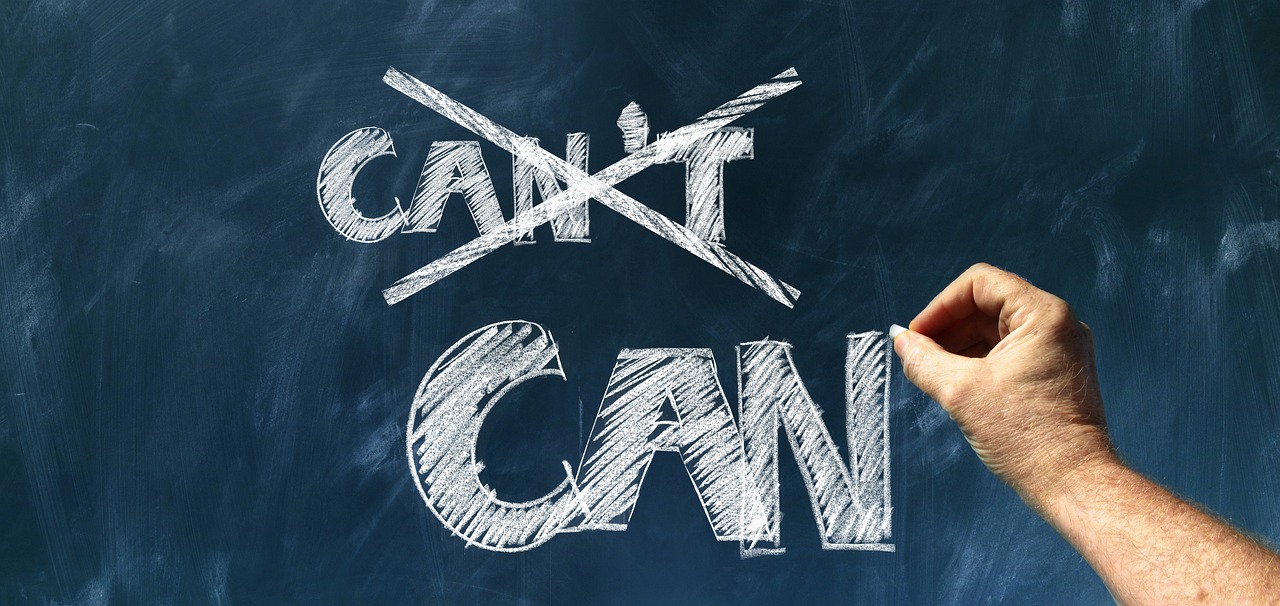
Building Confidence
Confidence is the bedrock of effective self-defense. Imagine standing in a room full of people, and suddenly, a fire alarm goes off. The way you react in that moment can depend heavily on your confidence level. If you believe in your ability to handle the situation, you'll be more likely to take charge and guide others to safety. In self-defense, this principle holds true. When you feel confident, you're not just prepared to react; you're empowered to act decisively.
Building confidence in self-defense involves a combination of training, mental exercises, and real-life practice. First and foremost, regular training is essential. The more you practice various techniques—be it striking, blocking, or escaping—the more comfortable you become with your body and its capabilities. This familiarity breeds confidence. You start to understand that you possess the skills necessary to protect yourself, which can be incredibly empowering.
Moreover, mental exercises play a pivotal role in boosting your confidence. Visualization techniques can be particularly effective. Picture yourself in a self-defense scenario, successfully defending against an attacker. By mentally rehearsing these situations, you create a sense of familiarity and preparedness in your mind. This mental rehearsal can make a world of difference when faced with a real threat.
Another key aspect of building confidence is fostering a positive mindset. Self-talk is a powerful tool. Instead of focusing on self-doubt or fear, remind yourself of your training and capabilities. Phrases like "I am capable," or "I can handle this," can significantly alter your mental state. Surrounding yourself with supportive individuals who encourage your growth can also enhance your confidence levels. Engaging in discussions about self-defense with peers or mentors can reinforce your belief in your abilities.
Lastly, consider participating in scenario-based training. This type of practice simulates real-life situations and forces you to think on your feet. It’s one thing to practice techniques in a controlled environment, but applying them under pressure is where true confidence is forged. Through these experiences, you learn to trust your instincts and react appropriately, further solidifying your self-defense skills.
In summary, building confidence in self-defense is a multifaceted process that requires dedication, mental preparation, and supportive environments. By committing to regular practice, employing visualization techniques, maintaining a positive mindset, and engaging in realistic training scenarios, you can cultivate a strong sense of self-assurance that will serve you well in any situation.
- How long does it take to build confidence in self-defense? Confidence builds over time with consistent practice and training. Each individual’s journey will vary based on their background and dedication.
- Can mental preparation really impact my self-defense skills? Absolutely! Mental preparation can enhance your ability to react under pressure, making you more effective in real-life situations.
- What are some quick ways to boost my confidence before a self-defense class? Positive self-talk, deep breathing exercises, and visualizing successful outcomes can help boost your confidence before training.
- Is it necessary to train with a partner to build confidence? While training with a partner can be beneficial, solo drills and mental exercises can also significantly enhance your confidence levels.

Importance of Practice
When it comes to mastering self-defense techniques, regular practice isn't just a suggestion—it's a necessity. Think of it like learning to ride a bike: the more you practice, the more comfortable and confident you become. Self-defense is no different. It’s not enough to just learn the techniques; you need to embed them into your muscle memory so that they become second nature. Imagine being in a high-pressure situation where every second counts. Wouldn’t you want your response to be instinctive rather than a product of panic? This is why practice is crucial.
Consistent training allows you to refine your skills, improve your reaction times, and build your confidence. Each time you practice, you are not just repeating movements; you are also enhancing your understanding of how and when to apply these techniques effectively. For example, practicing defensive maneuvers like blocking and redirecting attacks regularly can make a significant difference in how you respond to real-life threats. The body learns through repetition, and the more you practice, the better equipped you will be to handle unexpected situations.
Moreover, practicing self-defense techniques in a controlled environment helps reduce anxiety associated with confrontations. You become familiar with the movements and the scenarios in which you might need to use them. This familiarity breeds comfort and assurance. In fact, many self-defense programs incorporate scenario-based training, which helps you visualize and mentally prepare for potential threats. By simulating real-life situations, you not only improve your physical skills but also your mental preparedness.
To illustrate the importance of practice, consider the following table that outlines the benefits of consistent self-defense training:
| Benefit | Description |
|---|---|
| Muscle Memory | Repetition helps your body remember movements, making them instinctual. |
| Increased Confidence | Regular practice builds self-assurance, enabling decisive action in emergencies. |
| Improved Reaction Time | Frequent drills enhance your ability to respond quickly to threats. |
| Stress Management | Practicing in a controlled environment reduces anxiety about real-life confrontations. |
| Realistic Scenario Training | Simulating threats prepares you mentally and physically for actual situations. |
In conclusion, the importance of practice in self-defense cannot be overstated. It is the bridge that connects knowledge and action, transforming theoretical techniques into effective responses. So, whether you're a beginner or someone looking to sharpen your skills, make it a point to practice regularly. Remember, in the world of self-defense, practice isn't just about repetition; it's about preparation.
- How often should I practice self-defense techniques?
It's recommended to practice at least once a week, but more frequent sessions can enhance your skills faster.
- Can I practice self-defense alone?
While some techniques can be practiced solo, working with a partner or instructor is ideal for feedback and safety.
- What should I focus on during practice sessions?
Focus on a mix of physical techniques, mental preparedness, and situational awareness to build a well-rounded skill set.
Frequently Asked Questions
- What is self-defense?
Self-defense is the ability to protect oneself from harm, both physically and mentally. It involves understanding when and how to use various techniques to defend against an attacker, while also considering the legal and ethical implications of those actions.
- Why is mental preparedness important in self-defense?
Mental preparedness is crucial because it helps you remain calm and focused in high-stress situations. Being mentally ready allows you to assess threats accurately, make quick decisions, and execute self-defense techniques effectively when needed.
- What are some basic physical techniques used in self-defense?
Basic physical techniques include striking methods like punches and kicks, as well as defensive maneuvers such as blocking and escaping. Each technique is designed to empower individuals to respond effectively to potential threats while minimizing risk.
- How can I improve my striking techniques?
Improving your striking techniques involves practicing proper form, targeting specific areas on an attacker, and focusing on speed and power. Regular training and drills can help enhance your skills and confidence in executing these techniques.
- What role does situational awareness play in self-defense?
Situational awareness is vital for identifying potential threats before they escalate. By being aware of your surroundings and recognizing warning signs, you can take proactive steps to avoid dangerous situations altogether.
- How often should I practice self-defense techniques?
Consistency is key! Regular practice is essential for mastering self-defense techniques. Aim for at least a few sessions each month, incorporating drills and scenario-based training to reinforce your skills and improve response times.
- Can self-defense training help build my confidence?
Absolutely! Self-defense training can significantly boost your confidence. As you learn and practice techniques, you'll feel more empowered to handle potential threats, which translates into a greater sense of security in your daily life.
- Are there legal considerations I should be aware of in self-defense?
Yes, understanding the legal implications of self-defense is crucial. Laws vary by location, but generally, self-defense must be proportional and necessary. Knowing when and how to apply self-defense techniques can help you stay within legal boundaries.
- What if I have no prior experience in self-defense?
No problem! Self-defense classes cater to all skill levels, including beginners. Instructors will guide you through the basics, helping you build a solid foundation and gradually develop your skills and confidence.


